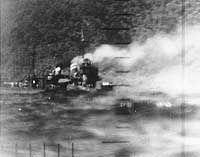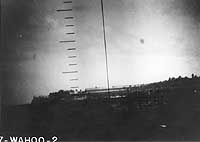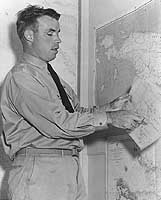
At the end of December 1942, following two lackluster war patrols, USS Wahoo received a new Commanding Officer, the very aggressive and talented Dudley W. Morton. With a spirited pep talk about his intentions and expectations, Morton raised morale among his officers and crew. He implemented a number of innovations, among them placing Executive Officer Richard H. O'Kane at the periscope, so that the Commanding Officer could focus on the complete tactical picture instead of just on what could be seen through that one sensor.
To begin her third war patrol, Wahoo stood out of Brisbane, Australia, in mid-January 1943, with orders to reconnoiter Wewak, a Japanese base on the northern side of New Guinea, then attack shipping in the waters beyond. Using only a home-made chart, on 24 January Morton took his submarine into Wewak harbor, torpedoed and badly damaged the destroyer Harusame at close range and escaped unscathed. Two days later, Wahoo encountered a convoy, sank a freighter and the transport Buyo Maru and damaged another cargo ship. Wahoo made additional attacks on a tanker and a freighter. Afterwards, she reported by radio: "In ten-hour running gun and torpedo battle destroyed entire convoy of two freighters one transport one tanker ... all torpedoes expended".
After an escort ship thwarted his attempt to use Wahoo's deck gun against another convoy on 27 January, Morton made a second radio report: "Another running gun battle today. Destroyer gunning, Wahoo running". Subsequently, the submarine conducted a photographic reconaissance of Fais Island, near Ulithi Atoll, then headed for Pearl Harbor. She arrived on 7 February 1943, with a broom lashed to her periscope to signify a "clean sweep" of enemy targets. Receiving a hero's welcome, Wahoo's exploits were widely publicized, boosting the confidence of both the American Public and of other members of the Submarine Force.
This page features all the views we have related to USS Wahoo's third war patrol, in January-February 1943.
For other images related to USS Wahoo, see:
| If you want higher resolution reproductions than the digital images presented here, see: "How to Obtain Photographic Reproductions." |
Click on the small photograph to prompt a larger view of the same image.
|
Photo #: NH 42275 USS Wahoo (SS-238) Provides food and water to the crew of a becalmed fishing boat, circa January 1943. The original caption, released with this photograph on 3 March 1943, reads: "Act of Mercy -- While on the war patrol during which she sank a Japanese destroyer and a convoy of four ships, the submarine Wahoo, commanded by LCdr. Dudley W. Morton, USN, of Miami, Fla., came across a small fishing boat, becalmed. Three of the crew of nine aboard the fishing vessel had died when the submarine found her. Three remaining crew members were without food and water. This picture shows members of the submarine's crew handing water and food to the men in the fishing vessel. A few days later the Wahoo destroyed the Japanese destroyer and convoy." View looks forward from Wahoo's machinegun platform. Official U.S. Navy Photograph, from the collections of the Naval Historical Center. Online Image: 113KB; 740 x 625 pixels |
 |
|
Photo #: 80-G-35738 Harusame (Japanese destroyer, 1937-1944) Periscope photograph, taken from USS Wahoo (SS-238) after she had been torpedoed by the submarine near Wewak, New Guinea, on 24 January 1943. Harusame's back is clearly broken, but she was repaired and returned to service despite this heavy damage. Wartime intelligence evaluated this photo as showing one of the Asashio class (see Photographic Intelligence Report # 82, 17 March 1943). However, the ship's bridge structure identifies her as a Shiratsuyu class destroyer, with the # 2 (single) 5" gun mount removed. Official U.S. Navy Photograph, now in the collections of the National Archives. Online Image: 83KB; 740 x 605 pixels Reproductions of this image may also be available through the National Archives photographic reproduction system. |
 |
|
Photo #: 80-G-37033 USS Wahoo (SS-238) Lieutenant Commander Dudley W. Morton, Commanding Officer, with another officer (probably Lieutenant Richard H. O'Kane), in Wahoo's conning tower during her attack on a Japanese convoy north of New Guinea, 26 January 1943. Several ships, among them the transport Buyo Maru, were sunk in this action. Official U.S. Navy Photograph, now in the collections of the National Archives. Online Image: 75KB; 740 x 595 pixels Reproductions of this image may also be available through the National Archives photographic reproduction system. |
 |
|
Photo #: 80-G-37034 USS Wahoo (SS-238) Lieutenant Richard H. O'Kane, Executive Officer, at the periscope during Wahoo's attack on a Japanese convoy north of New Guinea, 26 January 1943. Several ships, among them the transport Buyo Maru, were sunk in this action. Official U.S. Navy Photograph, now in the collections of the National Archives. Online Image: 51KB; 740 x 600 pixels Reproductions of this image may also be available through the National Archives photographic reproduction system. |
 |
|
Photo #: 80-G-39746 Buyo Maru (Japanese transport, 1919) Periscope photograph, showing the ship sinking after she was torpedoed by USS Wahoo (SS-238) north of western New Guinea on 26 January 1943. (See: "Photographic Intelligence Report # 82, 17 March 1943") Official U.S. Navy Photograph, now in the collections of the National Archives. Online Image: 84KB; 740 x 515 pixels Reproductions of this image may also be available through the National Archives photographic reproduction system. |
 |
|
Photo #: 80-G-38602 USS Wahoo (SS-238) Scene in the control room during Wahoo's 27 January 1943 action with a Japanese destroyer. When the photo was taken the submarine was at 300 feet, rigged for depth charges. Six charges had just gone off and the crew was awaiting more. Lieutenant Commander Dudley W. Morton, Wahoo's Commanding Officer, reported this action as: "Another running gun fight ... destroyer gunning ... Wahoo running". Shaved head on crewman at right is a product of an Equator crossing ceremony three days previously. Official U.S. Navy Photograph, now in the collections of the National Archives. Online Image: 67KB; 740 x 600 pixels Reproductions of this image may also be available through the National Archives photographic reproduction system. |
 |
|
Photo #: 80-G-39745 Fais Island (near Ulithi Atoll, Caroline Islands) Periscope photograph, taken by USS Wahoo (SS-238) on 27 January 1943. The view shows a refinery and large warehouse adjacent to a phosphate works. Wahoo had intended to shell the latter, but had to break off when an enemy ship came on the scene. (See: "Photographic Intelligence Report # 82, 17 March 1943") Official U.S. Navy Photograph, now in the collections of the National Archives. Online Image: 49KB; 740 x 550 pixels Reproductions of this image may also be available through the National Archives photographic reproduction system. |
 |
|
Photo #: NH 42274 USS Wahoo (SS-238) Arrives at Pearl Harbor at the end of her third war patrol, circa 7 February 1943. The original caption, released with this photograph on 3 March 1943, reads: "Hero's Wecome -- A Navy band is on hand to greet the submarine Wahoo on her return to Pearl Harbor following a patrol during which she sank a Japanese destroyer and an entire enemy convoy of four ships. The battle with the convoy lasted for a period of 14 hours." Note that Wahoo's radar antennas have been crudely censored out of the image. Official U.S. Navy Photograph, from the collections of the Naval Historical Center. Online Image: 93KB; 740 x 625 pixels |
 |
|
Photo #: 80-G-35726 USS Wahoo (SS-238) At Pearl Harbor, soon after the end of her third war patrol, circa 7 February 1943. Her Commanding Officer, Lieutenant Commander Dudley W. Morton, is on the open bridge, in right center. Officer standing at left appears to be the Executive Officer, Lieutenant Richard H. O'Kane. Note: broom lashed to the periscope head, indicating a "clean sweep" of enemy targets encountered; pennant bearing the slogan "Shoot the sunza bitches" and eight small flags, representing claimed sinkings of two Japanese warships and six merchant vessels. Note that the forward radar mast, mounted in front of the periscope shears, has been censored out of this photograph. Official U.S. Navy Photograph, now in the collections of the National Archives. Online Image: 76KB; 595 x 765 pixels Reproductions of this image may also be available through the National Archives photographic reproduction system. |
 |
|
Photo #: 80-G-35725 Lieutenant Commander Dudley W. Morton, USN, Commanding Officer, USS Wahoo (SS-238), at right With his Executive Officer, Lieutenant Richard H. O'Kane, on Wahoo's open bridge, at Pearl Harbor after her very successful third war patrol, circa 7 February 1943. Official U.S. Navy Photograph, now in the collections of the National Archives. Online Image: 85KB; 740 x 605 pixels Reproductions of this image may also be available through the National Archives photographic reproduction system. |
 |
|
Photo #: 80-G-35733 Lieutenant Commander Dudley W. Morton, USN, Commanding Officer, USS Wahoo (SS-238) Describes his submarine's successful third war patrol, during a press conference at Pearl Harbor, circa mid-February 1943. He is holding a rough chart of what appears to be a small part of the northern New Guinea coast. On the wall at right are charts of western New Guinea and of the Iron Bottom Sound area between Guadalcanal and Tulagi. Official U.S. Navy Photograph, now in the collections of the National Archives. Online Image: 94KB; 595 x 765 pixels Reproductions of this image may also be available through the National Archives photographic reproduction system. |
 |
For other images related to USS Wahoo, see:
| If you want higher resolution reproductions than the digital images presented here, see: "How to Obtain Photographic Reproductions." |
Page made 6 February 2002